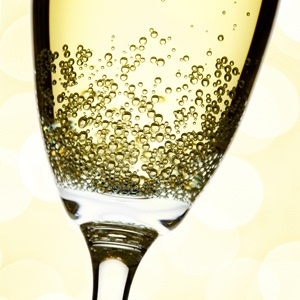Making Sparkling Wine
There are several ways of putting bubbles in bottles and the easiest way to tell which has been used is to look at the price. So starting with the cheapest way…
Injection – ever had a Soda Stream? Well this is what happens to all basic sparkling wine. The wine is made in the normal way and then CO2 is injected to give it some fizz. Cork in, label on, out to the public. This is great party fizz, ideal to mix with orange juice or peach nectar and comes in a variety of sweetness from Brut (dry) to Doux (sweet) with every shade in between.
Secondary fermentation.
All the best sparkling wines of the world get their bubbles through a secondary fermentation. Remember the equation
C6H12O6 => 2C2H5OH + 2CO2
or
Sugar + Yeast = Alcohol and CO2?
This is where the CO2 becomes important. The wine is made in the normal way, fermenting, fining and filtering as normal. Generally this ‘base wine’ as it is called, is drier than normal white wine and tends to have slightly lower alcohol. The wine is bottled and then, a little extra sugar and yeast are added and the bottle is sealed with a crown cap like a beer bottle. The sugar and yeast then start to ferment in the bottle producing slightly more alcohol and – most importantly – lots of lovely bubbles. Obviously, the bubbles have nowhere else to go so they become absorbed in the wine giving it that great fizzing feeling.
The only problem now is that, having done their work, the yeast cells die. They can’t be allowed to stay in the bottle as they will make the wine look cloudy – but how do you get them out without losing the bubbles? In big commercial operations, the bottles are opened and the contents are shot out into a pressurised tank. The wine is then cleaned and put back into new bottles, still under pressure thus retaining the bubbles. This is called the Transfer Method and produces good quality sparkling wine although the bubbles are not as fine as in the champagne method.
Champagne Method. This is how all the best sparkling wines in the world are made and there are various names around the world for this method, also known as the Traditional Method. In Spain wines made in this way are called Cava, in Germany it’s Sekt and here in South Africa, they are Cap Classiques. The important difference between Champagne Method and Transfer Method is that the fermentation takes place in the exact same bottle as the one in which it is sold.
In order for this to happen, the wine has to undergo a few complicated processes to remove the dead yeast cells. Whilst that is going on, important flavour changes are taking place in the wine which mean that Champagne Method wines have that all-important biscuit/yeasty flavour. When the second fermentation has finished, the bottles are laid down to rest – this is when most of the flavour from the dead yeast cells is absorbed – this is called yeast autolysis.
After some time, a process called riddling begins – either by hand or more commonly now by machines called gyropalettes. This involves twisting the horizontal bottles over a period of days or weeks and as they are turned, gradually tilting them more and more until eventually they are facing neck-downwards. This causes all the dead yeast cells to slowly and gradually accumulate right down in the neck of the bottle.
Once this has been achieved, the bottles are loaded onto a machine (still neck-downwards) which freezes this clump of dead yeast cells with dry ice. The bottle is then flipped over, the cap removed, the frozen pellet of gunk flies out (this is known as disgorgement), the sweetness of the wine is adjusted by the addition of wine and sugar syrup (dosage), the cork is put in and the wire netting placed on top. And all of this happens in a matter of seconds! The wine is then rested again before being labelled and sent to the shops.
So this is why ‘proper’ champagne or cap classiques cost so much – they just take a lot longer to make and involve very costly equipment. Are they worth it? Oh yes!
Tank Method or Charmat Method. Named after Frenchman Eugene Charmat who invented it, this also involves a secondary fermentation, but one which takes place in bulk within a sealed tank. The wine is cleaned up whilst still in the tank and then piped off under pressure to bottles. This method is very cost-effective and makes for fairly good quality bubbles, but the special yeasty/biscuit flavours of genuine champagne are generally missing.

